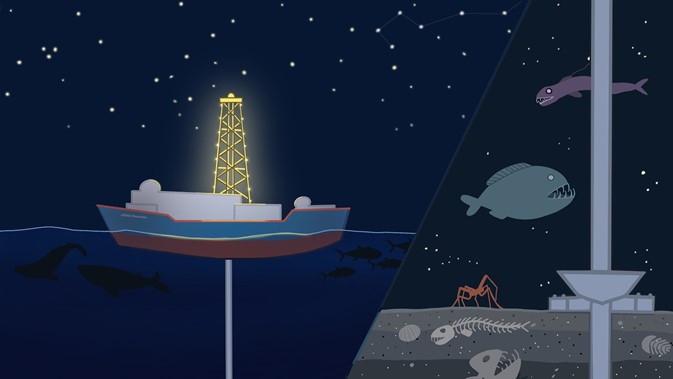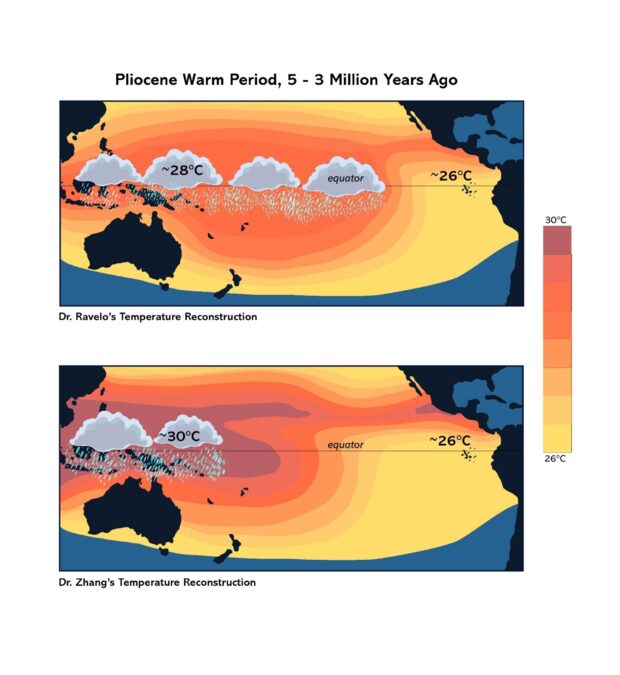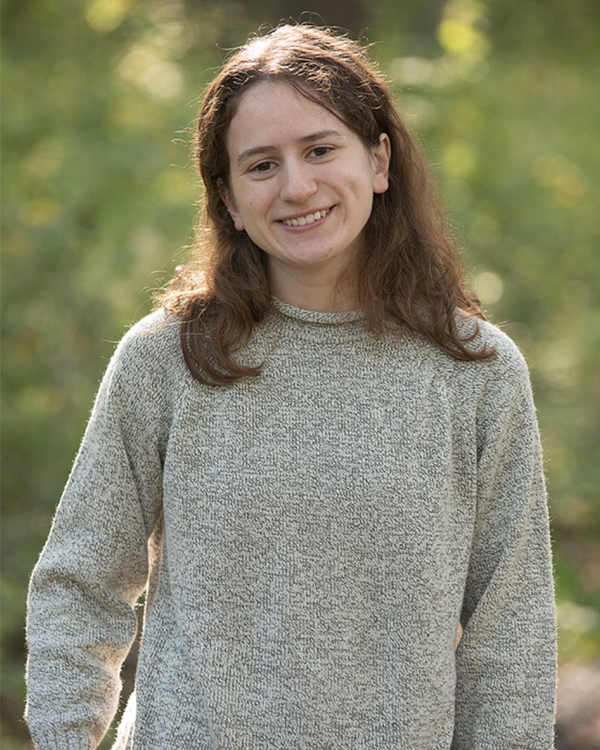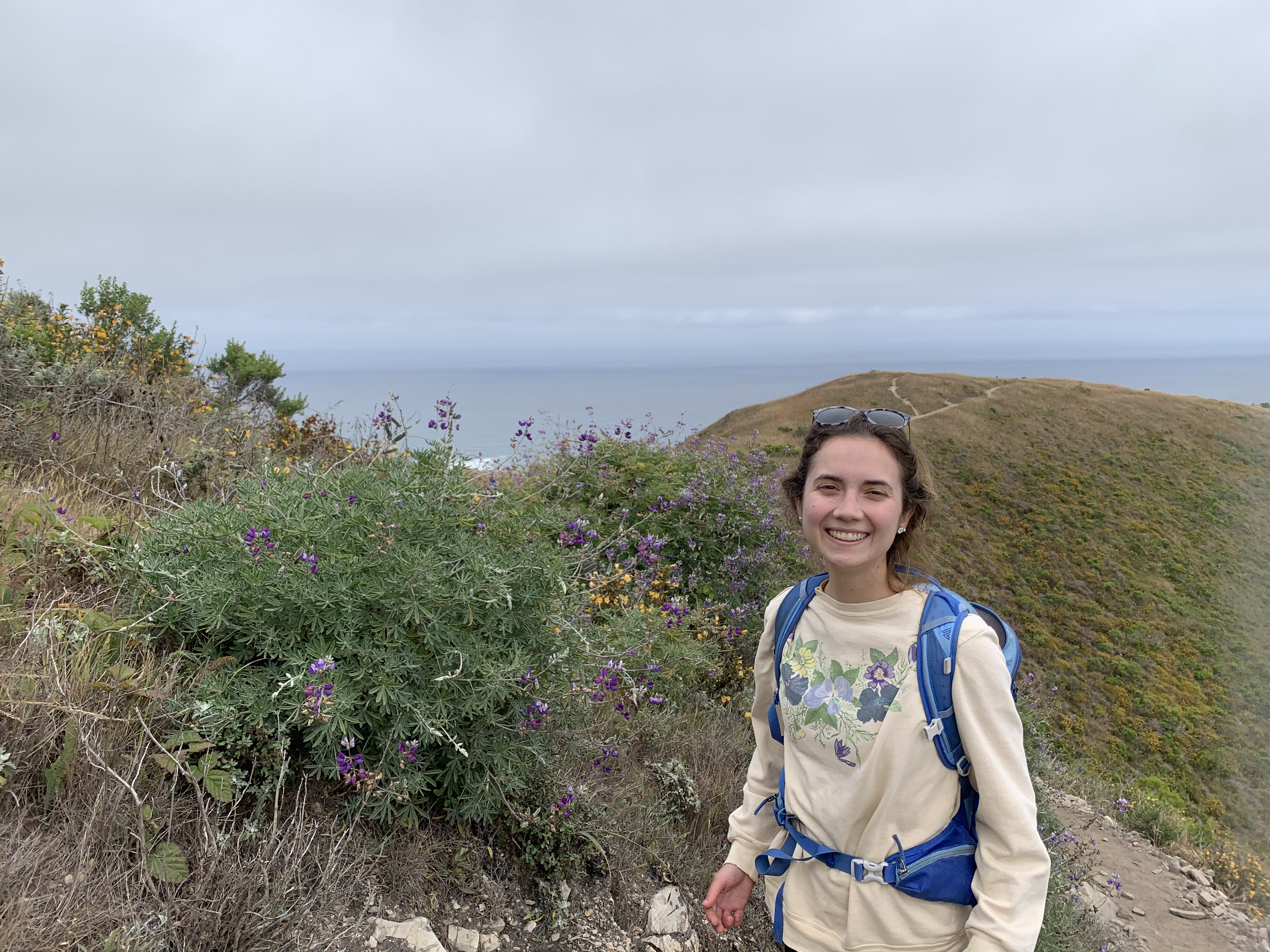The Once and Future Earth
Studying past climates can help us prepare for climate change, but what the world looked like millions of years ago is up for debate. Freda Kreier reports. Illustrations by Amanda Riley and Avery Williams.

Illustration: Avery Williams
For Christina Ravelo, the past is not only prologue. It’s also a window into the future.
It’s past midnight on November 24, 2016. The deep-sea drilling vessel Resolution is bobbing up and down in the middle of the Pacific Ocean. The closest landmass is New Guinea, 5,000 miles to the west.
Just two degrees north of the equator, the air is dripping with humidity when Ravelo hears the captain’s voice crackling over the ship’s speakers.
“Core on deck!”
The announcements sets of a flurry of activity on the deck outside Ravelo’s open door. A faded yellow derrek looms over the heads of technicians as they pull aboard a long plastic tube, still cold from its journey up from the depths. It’s the reason the ship is here. The Joint Oceanographic Institutions for Deep Earth Sampling (i.e. “The Resolution”) is a scientific drilling ship with the mission to drill for ancient sediments, called “cores,” from beneath the seafloor.
The crew moves with practiced precision as they carry the core across the deck to a promenade outside the ship’s lab. This core is special: the last time this area of the Pacific was drilled to study Earth’s past was in 1991. That core launched a scientific controversy that continues to rage to this day.
At the center of the melee is Ravelo. Over 20 years ago, she studied the 1991 core to find out how warm the western Pacific Ocean was millions of years ago. Contrary to what everyone expected, Ravelo’s analysis of the 1991 core found that the ancient western Pacific was around the same temperature it is today. Other scientists dispute her findings, claiming that the elevated levels of greenhouse gases in the past would have made the tropical Pacific Ocean a lot warmer.
This isn’t just an academic debate about the distant past. Scientists use past climates to predict how the natural world will change as the planet warms. The equatorial Pacific is the largest body of warm water on the planet and a keystone of global climate.
The 1991 core is the only sample ever to be used to recreate past climates of this critical area of the Pacific Ocean. Now, the core the crew has just brought aboard brings the tally to two. With this second sample, Ravelo hopes to bolster her results and put the controversy to bed. But one of the scientists who disagrees with Ravelo is also onboard. He too is hoping to put an end to the debate—by proving Ravelo wrong.
But that will need to wait. For now, their job is to help the crew of the Resolution preserve and protect the samples until they can get back to land. It will be many years before they have their results. The sound of a saw pierces through the lab door as the technicians cut the core, and the Resolution bobs up and down in the middle of the midnight sea.
A smudge in the sea
Ravelo didn’t always plan on sailing the high seas. Her parents, first-generation immigrants from Cuba and the Philippines, hoped that their daughter would translate her love of the natural world into a career in medicine. But when Ravelo attended Stanford in the 1980s, she felt out-of-place in the large, impersonal biology lectures.
“I didn’t know any female scientists or any scientists of color,” she recalled. “I felt like a fraud. I couldn’t see myself as a scientist, even though I wanted to be one.”
Ravelo was increasingly drawn to the small geology department. She liked how the geology professors rewarded collaboration, so wholly different from the vicious competition among pre-med students. Her experience at Stanford inspired her to pursue a PhD in geological sciences at Columbia University, and later a professorship at the University of California, Santa Cruz.
Ravelo is a paleoceanographer—a scientist who studies ancient oceans. Her specialty is reconstructing ocean temperatures during the Pliocene, a geological epoch between 3-5 million years ago. The Pliocene holds a special interest among climate scientists because it was the last time before the modern era when carbon dioxide levels in the atmosphere were above pre-industrial levels.
The Pliocene affords scientists a glimpse into our future. Even if we curb greenhouse gas emissions, we’ve already added enough CO2 into the atmosphere to drastically change the planet. Right now, our planet is adjusting to these new levels of greenhouse gases, with the same grace of a teenager going through puberty. Because CO2 levels were consistently high for millions of years during the Pliocene, this period in earth’s history helps us understand what our planet will look like after it’s adjusted to climate change.
“Everyone wants to know about the future,” says Yair Rosenthal, a paleoclimatologist at Rutgers University. “At least, that’s how I sell my papers!”
Rosenthal says that conversations around global warming were picking up steam during the 1980s, when both he and Ravelo were graduate students at Columbia. Some of what paleoclimatologists were finding out about the Pliocene will be familiar; high CO2 levels raised global temperatures, melted the ice caps, and raised sea levels by a stunning 32 feet.
Ravelo is passionate about discovering what oceans were like during the Pliocene. Ocean temperatures are major divers of global climate, shaping weather phenomena such as how much rain falls in Oregon to how many typhoons hit Japan.
In 1991, almost nothing was known about this area of the Pacific Ocean during the Pliocene. Scientists’ best guess of what this area was like 3 million years ago were based around climate models (computer programs that simulate climate), which predicted that the already balmy waters of the western Pacific were 2-4°C warmer during the Pliocene.
Ravelo measures magnesium levels in fossilized shells to reconstruct past ocean temperatures. That’s because ocean microorganisms called foraminifera integrate magnesium into their shells when the water is warm. When she studied the magnesium levels in the 1991 core, Ravelo found that water temperatures in the western Pacific looked weirdly similar to today, hovering around 28°C.
Her results directly contradicted model predictions. But then the story got even stranger. Other scientists working on cores they’d collected off the coast of South America found that the eastern Pacific—notorious for being frigid—was a lot warmer than climate models predicted. It was as if all the extra heat that was supposed to be collecting in the western Pacific had been smudged by an invisible thumb all the way to Peru.
In fact, it looked a lot like an El Niño event.
Let’s take a step back. The equatorial Pacific Ocean is defined by warm tropical waters in the west around Indonesia and Hawaii, and freezing water around South America in the east. To put it another way, a surfer in Tahiti only needs to wear a speedo, while a surfer in Peru needs a long-sleeved wetsuit and a cup of hot coffee waiting in the car to tolerate the cold.
The weather created by this cold-hot temperature ocean gradient is the reason why there are rainforests in Bali and why the driest deserts on earth are in South America. But every two to seven years, all that hot water around Indonesia starts moving east and eventually settles off the coast of Peru.
This temperature smudging is what scientists call an El Niño event. El Niños flip the script for global weather patterns. Deserts in South America flood, and the monsoons come late to Southeast Asia. El Niños are disruptive for agriculture, fisheries, and the many plants and animals that have adapted to dry climates in America and wet climates in Asia.
El Niños are also completely natural—but they are anomalies to the Pacific’s normal state. That’s why Ravelo’s results were so strange. By adding up the results from the 1991 core with the work of her colleagues in South America, it was starting to look like El Niños during the Pliocene were the norm. Unlike today, when El Niños are an aberration – with disruptive, if not catastrophic, implications.
El Niño forever
In 2005, Ravelo and her colleagues published their findings in the world’s most prestigious journal, Science. They named their theory ‘permanent El Niño conditions,’ and later ‘El Padre.’ Ravelo says that their results were met with interest by some and polite skepticism from others.
“We understand that El Padre is a hard observation to swallow,” says Ravelo. “It was a huge surprise to a lot of people because no climate models indicated that this was true.”
Some of those climate models also fail to predict a return to El Padre due to climate change. But a growing number of climate scientists and computer modelers are coming out in favor of the idea that the Pacific will enter an average El Niño state sometime in the 21st century.
Yair Rosenthal, co-chief scientist aboard the Resolution in 2016, is one of them.
“Ravelo is a good scientist. She doesn’t take any shortcuts, and she’s one of the most rigorous scientists I know,” he says. “I have the highest respect for her.”
A return to the El Padre state is a possibility that climate scientist Dannielle Lemmon at Pusan State University is willing to consider. Lemmon says that while predicting climate is notoriously tough, a Pacific Ocean where El Padre reigns supreme is likely to mimic the climate trends of an El Niño event, meaning delayed monsoons in South East Asia and Oceania and flooding on the west coast of the Americas.
In the last few decades, scientists have linked severe or extended El Niño events to anything from the fall of ancient civilizations to the 1788 French Revolution. Lemmon describes El Niños as a food security threat in South East Asia because El Niños are associated with drought in the region.
But the effects of El Niños are felt all over the world. A near-permanent El Niño state could be catastrophic.
“This isn’t just an academic lecture,” Lemmon says. “It makes a real impact on people’s lives.”
But not everyone is onboard with Ravelo’s theory. Critics point out that Ravelo’s claims of a permanent El Niño state are largely based on evidence from a single core. That criticism is what brought Ravelo to the 2016 cruise aboard the Resolution, where she hoped to collect more data to support her theory.
She soon found out she wouldn’t be alone; Rosenthal warned her that she’d be joined by a scientist whose theories couldn’t be farther from her own.
Says Rosenthal; “I called Christina and I told her, ‘I’m inviting Yige. I want you guys to fight.’”
Proxy Wars
One deck below the core lab on November 24, 2016, a group of junior researchers furiously study the chunky white core that’s just been brought aboard. One of them is a young paleoclimatologist from Texas A&M by the name of Yige Zhang. He examines the core for warning signs of explosive gas that could blow up the whole ship.
“They say we’re the most important people on the ship. We could call off the whole operation,” he says, adding a little sheepishly: “But apparently, that’s never happened.”
Zhang also plans to study the core to reconstruct ocean temperatures, though he uses ancient fats rather than magnesium as a proxy. In 2014, Zhang published results arguing against Ravelo’s concept of an El Padre state during the Pliocene.
Zhang had first heard about Ravelo’s El Padre hypothesis as a graduate student at Yale University in the late 2000s. Excited by Ravelo’s findings, he attempted to recreate them using the same core Ravelo had used in her research.
“We didn’t expect anything to be different,” says Zhang. But Zhang’s results contradicted Ravelo’s; by analyzing fats found in the core, Zhang concluded that the waters in the western Pacific were a lot warmer during the Pliocene, in line with model predictions.

Ocean temperatures in the Pacific would have played a big role in shaping weather during the Pliocene. Illustration: Amanda Riley
Zhang worried that he had made a mistake. But his advisor, the late geologist Mark Pagani, suspected that changes in sea chemistry over the last few million years may have affected Ravelo’s analysis, leading her to falsely conclude that the western Pacific was cooler than previously thought. He and Zhang published their conclusions in 2014.
Ravelo was taken aback by the tone of the paper.
“I don’t know if I want to use the word ‘aggressive’ or ‘confrontational’,” she says. “But it was a little bit surprising that [the paper] seemed so focused on tearing down an idea that came from my lab.”
Now a professor in his own right, Zhang is confident that he interpreted his results correctly. Despite Rosenthal’s desire to see a “fight’ on board the Resolution, his disagreement with Ravelo is polite and purely professional.
Both Zhang and Ravelo have now had the opportunity to analyze the 2016 core to beef up their findings. But if the scientific community is hoping for a confirmation of either theory, they’re in for a letdown.
“We got the same samples, and it sounds like we’re producing different results again,” says Zhang, chuckling.
The future, three million years ago
The planet is in transition. In 2013, CO2 levels in the atmosphere reached levels the earth hasn’t seen in 3 million years. For climate scientists, this means one thing: without carbon capture technology (and lots of it), the climate is going to change.
“Pliocene studies used to be a warning about what we didn’t want to happen. Now, they’re about what will happen,” says Mark Chandler, a climate modeler at Columbia University. “Most of what we’ve found about studying warm paleoclimates tells us that the future is going to be a lot worse than climate models predict.”
What will that world look like? The work of scientists like Zhang argues that the western Pacific will keep absorbing heat. Coral and other ocean life in these tropical waters will need to adapt or die. But the current hot-cold gradient between the east and west will remain in place. El Niños will remain an aberration, though they’ll likely be more intense.
Ravelo thinks things will unfold differently. She predicts that permanent El Niño conditions will erase today’s temperature gradient, which has persisted for millennia. The exact consequences are difficult to predict, but suggest that the life-giving monsoons will peter out in Southeast Asia, while the deserts that define the west coast of the Americas will drown beneath an ocean of rain.
The effects of both scenarios will be widespread and felt all over the globe. We don’t know which of these worlds our species will create. What scientist like Ravelo discover in the coming decades will determine how we prepare for the changing tide. For now, Ravelo keeps chipping away at the past, eager to catch a glimpse of the once and future earth.
© 2021 Freda Kreier / UC Santa Cruz Science Communication Program

Freda Kreier
Author
B.S. Liberal Arts (major: molecular biology) Colorado College
Internships: Nature, Good Times, SETI Institute
Freda Kreier is a science journalist who likes to write about public lands, the environment and DNA.
Freda completed her master’s in science communication from UC Santa Cruz at the height of the COVID-19 pandemic. Before becoming a journalist, Freda studied molecular biology at Colorado College (2017). She discovered she had a passion for storytelling while working for a podcast production company in Denver.
Her work to date appears in Nature, The Mercury News, Mongabay and more. She’s also worked on the anthropology podcast SAPIENS and Big Picture Science.

Avery Williams
Artist
B.F.A. Fine Arts, Lyme Academy of Fine Arts
Internships: Hawai’i Uncharted Research Collective, Academy of Science (San Francisco)
Avery Williams is an artist based in Kona, Hawai’i. She ventures in illustrative artwork focusing on the wonders of nature.

Amanda Riley
Artist
B.A. Environmental Science, Scripps College ‘19
Internships: Interpretive Media, Mount Rainier National Park
Amanda is a student at Cal State Monterey Bay’s graduate program in Science Illustration, gaining skills that will aid her in becoming an effective and engaging visual science communicator.
Though her favorite subjects to illustrate are mollusks and lepidopterans, she is eager to draw anything from the tiny scales of an insect to the inner layers of the Earth.
She relies on her degree in Environmental Science to interpret and explain elements of biology, ecology, and environmental processes. She believes her work can help make natural science accessible and inspiring, which is vital to protecting our planet’s biodiversity and climate.